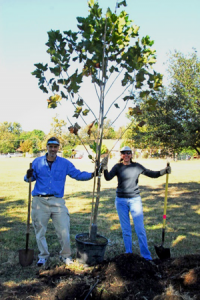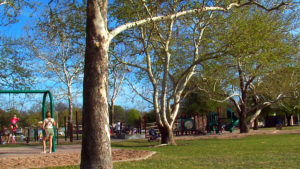If you haven’t yet seen it, we invite you to take a look at a film we made, We Planted 115 Trees, which documents the inspiring Friends of Brentwood Park project in November 2010. There’s a separate clip about the donors and honorees of 15 trees dedicated in the park.
 FOBP is the latest in a long line of individuals and groups who have helped maintain our park over the past 60 years. Long before Brentwood and Crestview were developed, this area was described as “rich farming lands that were once illimitable prairies.” Crops included corn and cotton. Several farmers had dairies. There were few trees anywhere.
FOBP is the latest in a long line of individuals and groups who have helped maintain our park over the past 60 years. Long before Brentwood and Crestview were developed, this area was described as “rich farming lands that were once illimitable prairies.” Crops included corn and cotton. Several farmers had dairies. There were few trees anywhere.
On March 6, 1950, one Crestview neighbor, Eva Mae Waggoner (known to neighbors as Mae), moved with her husband and children to a new home on the south side of Justin Lane. (Homes on both sides of that part of Justin are considered to be in Crestview.) It was a bitterly cold day. Several homes on the block, including Mae’s, had no heat. Mae and her husband “lit a fire” under the responsible parties, and they all soon were snug and warm in their new homes.
After settling in, Mae and her husband focused their energies on raising their two children and improving the new Brentwood Park behind their house. The cornfield between Brentwood Elementary and homes on Justin Lane became Brentwood Park about 1951. The land had a few hackberry and walnut trees. Neighbors formed the Brentwood Recreation Club to help develop and maintain the school and park grounds. The city had no money for trees but offered to dig holes for them.
 While picnicking and fishing with a cousin along Onion Creek, Mae and her husband saw that the sycamore trees lining it were thick, practically choking it. They could have all the sycamores they wanted to plant in the park. Mae’s husband and other members of the Brentwood Recreation Club dug up the trees, hauled them to the park, and planted them. In 1952, the club held a festival on May 2 to raise funds for playground equipment, and it helped build the stage at Brentwood Elementary the next year. (Neighbors have said that beneath the stage was a bomb shelter, something often built during the Cold War of the 50s and 60s.)
While picnicking and fishing with a cousin along Onion Creek, Mae and her husband saw that the sycamore trees lining it were thick, practically choking it. They could have all the sycamores they wanted to plant in the park. Mae’s husband and other members of the Brentwood Recreation Club dug up the trees, hauled them to the park, and planted them. In 1952, the club held a festival on May 2 to raise funds for playground equipment, and it helped build the stage at Brentwood Elementary the next year. (Neighbors have said that beneath the stage was a bomb shelter, something often built during the Cold War of the 50s and 60s.)
In 1954, the club and the school’s PTA held their annual planting of trees at the school and park. Everyone was invited to:
“Bring your garden tools, and let’s make our school and park one of the most beautiful in town!”
For the first 10 years there was an activities director in the park each summer, Mae said. The school and park shared the grounds and the gym. Mae remembers regular potluck dinners, with volleyball games and horseshoe competitions.
In the winter there were dances in the school gym. “The Schlessingers were beautiful dancers, the Fred Astaire and Ginger Rogers of the neighborhood,” Mae said. They shared their talents by giving impromptu lessons in the waltz or the two-step to anyone who wanted to learn.
Mae was a regular visitor to the park for many years, well into her 80s, talking with neighbors and helping care for the trees. I met her when she visited the Community Tent at the Violet Crown Festival, held in the park. I coordinated the tent at the first four festivals, from 2003 to 2006. I remember how thunderstorms overnight preceded the 2006 festival, and the ground was saturated the next morning. As we scrambled to fill in soggy spots, Mae walked up and offered bags of mulch and her wagon to carry them from her garage to the park.
Today, the park is a mix of original and new trees, including the 115 planted by Friends of Brentwood Park in November 2010. FOBP volunteers continue to mulch and water the trees and other plantings, taking extra care of them during times of drought; they also participate each year in the city’s It’s My Park Day.
In 2011, FOBP completed a neighborhood survey and park master plan. It coordinated and raised funds for a new park pavilion, dedicated May 5, 2012, and a new walking trail, completed in Summer 2013. FOBP also helped coordinate the installation and maintenance of a purple martin house in the park beginning in 2012; it was placed in memory of neighbor Renald Ferrovecchio. Projects completed in 2014 include a new stainless steel drinking fountain (with a separate pet fountain), new backstop fencing, and six new benches for the park, thanks to a grant from the Austin Park Foundation; the dedication of FOBP co-founder Emily Wilson, who led the project; and coordination with Austin Parks and Recreation Department.
Learn more about FOBP here.
Thanks to neighbor Nancy Schuler for interviewing Mae in Spring 2005. Eva Mae Waggoner passed away June 12, 2018. You can read more about her life here.
